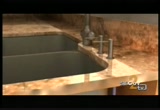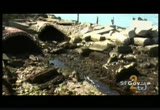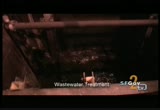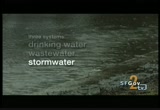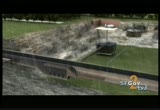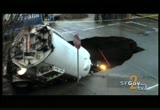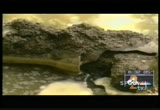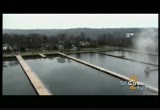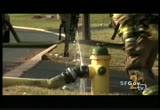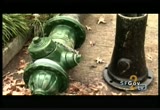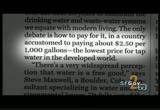tv [untitled] October 8, 2012 6:00am-6:30am PDT
6:00 am
6:01 am
modern civilization and life itself would be impossible without it. woman: okay, so today, we're going to look at how do we get our water? narrator: and today, it's a matter of simply turning on the tap. so often, we forget about the value of water. water is a commodity that is essential to life. 100 years ago, it would have been hard to imagine turning on the tap water. and now, it's an expectation. narrator: over 300 million people live in the united states. and each person uses an average of 100 gallons of water every day. man: what it takes to actually make clean water is somewhat a mystery to most customers. woman: so how does water get from the river into your house, or here at school? woman: somebody has to bring that water to us,
6:02 am
and somebody has to take it away when we're finished with it. man: the water infrastructure is vital for disease protection, fire protection, basic sanitation, economic development, and for our quality of life. man: you just can't visualize all the assets that are under our feet. we have about two million miles of pipe in this nation. if you're walking around in an urban area, you're probably stepping on a pipe. man: our grandparents paid for, and put in for the first time, these large distribution systems. woman: and in many cases, it's not been touched since. man: we're at a critical turning point. much of that infrastructure is wearing out.
6:03 am
narrator: our water infrastructure is made up of complex, underground systems that function continuously. these 10 locations take a look at the history, design, and challenges of our water infrastructure systems. each one represents a small part of what's at stake on a national scale. but understanding the challenges starts with understanding the value of the three basic systems. generations of americans have never experienced living without a constant, unlimited supply of water delivered straight to the tap, or without their waste flushed immediately away. i think people often forget -- because, you know,
6:04 am
water utilities have made it very convenient for people to get water -- how important this is. man: in terms of water supply, wastewater, stormwater development -- these are independent technologies. but what came first, most often, was a water supply system. the basic system is essentially the same as we used back in the 19th century. and in some cases, some of the same pipes. grusheski: philadelphia was the first american city to develop a water system and to take on as a municipal responsibility water delivery to all of its citizens. when william penn laid out the city, he actually chose a spot of land that had a lot of groundwater. however, by 1730, 30,000 people lived within the first seven blocks of philadelphia,
6:05 am
next to the delaware river. well, 30,000 people caused filth in the city and polluted their water sources. the groundwater was not potable. and in one year, 1/6 of the population died of yellow fever. now, they didn't know at the time that yellow fever was carried by mosquitoes. but the health issue was major in that first movement to build a water system. narrator: so they set out to find the cleanest source of water. although the majority of philadelphia's water now comes from the delaware river, early engineers found that development along the waterfront was causing pollution. so their search led them to the nearby schuylkill river. philadelphia developed technologies to pump water from the river into the city. these technologies established engineering concepts that are still the basis for our water systems today. europeans flocked here.
6:06 am
it was a destination point to see the new world technology. when charles dickens visited us in 1840, he was truly blown away by high water pressure on the fourth floor of the hotel he was staying in. nowhere in europe had he experienced that. this technology was doing something to support the life and the growth of the city. philadelphia, throughout the 19th century, was the major industrial city of the united states. all of these industries used water from this system. and it served as a prototype for many american cities, including pittsburgh and new york. man: new york city went to philadelphia and said, "you know, we're thinking of developing a hudson river water supply -- what do you suggest we do?" and they said, "we've had "a lot of problems on the schuylkill. "don't go to the hudson river. go to the upland and work by gravity."
6:07 am
and that's what new york city did. they first went to the hudson highlands, but 150 years later, it went to the delaware highlands. and really diverted the water that normally went to philadelphia to new york city. i don't think they anticipated that. narrator: the majority of new york city's drinking water comes from watersheds in upstate new york. a watershed is the area of land where water from rain or snow melt drains downhill into a body of water. mountains act as a funnel to feed rivers and lakes. and in this case, reservoirs. in the new york city system, water is collected and stored in 19 reservoirs, which can hold more than a year's supply -- over 580 billion gallons of water. almost all of the system is fed by gravity,
6:08 am
without the use of energy-consuming pumps. valves open to regulate the flow into the 85-mile-long delaware aqueduct -- the longest tunnel in the world. at hillview reservoir... the water is partitioned into another giant tunnel system. where it travels deep below manhattan. the pressure built up by gravity from the mountains pushes the water upwards toward the surface through vertical shafts.
6:09 am
these shafts feed the water mains of each neighborhood, which branch into smaller pipes below the streets... feeding into buildings and houses, into the plumbing, and finally, after its long journey, to our faucets. providing water to homes and industry is a monumental task, requiring immense infrastructure. but once the water is delivered and used, it must also be taken away. man: it's important that the waste generated by any society not be left around. cholera, and other diseases and problems, have been spread, because people wound up living in filth.
6:10 am
even the ancients understood that you couldn't have the sewage where you lived. and the easiest thing to do was transport it to another spot -- by water, or a river. most of the first sewer systems were on the east coast of the united states, often in places that already had developed a citywide water supply system. sullivan: in 1630, boston was basically three mountains, there were very steep hills. waste would run down quickly and dump into the harbor. and the tide would carry most of it away. well, this worked well for a while. the problem was, as boston wanted to expand, it started filling in the mudflats. the water could come rushing down the hill, it would hit the flat area and slow down. at high tide, it couldn't get out at all. it got so bad that the city took over, 'cause the city has a responsibility to protect its citizens.
6:11 am
boston built the first modern sewer system in the united states. ours was completed between 1877 and 1884. with this wonderful new sewer system, we were taking our filth and moving it out to the ocean. of course, all of this was untreated. in the 1960s, we were still pumping all of our sewage out to moon island, untreated. we would get swimmers here, never knowing, in the middle of summer, why you would have a cold. well, we were swimming in diluted sewage. melosi: the major way to deal with pollution, at least until early into the 20th century, was through the process of dilution. the assumption was that the capacity of rivers and streams, and even the seas, allowed for certain levels of pollution that eventually would purify themself.
6:12 am
as we get later into the 20th century, it becomes clear that the volumes of waste made dilution unworkable as a single solution. and so treatment became the ways in which we deal with pollution. narrator: to protect public health, starting in the 1950s and '60s, there was a push to put in wastewater treatment plants across the united states. today, with evolving technologies, the waste travels through multiple stages of treatment, removing tons of solids... settling out microscopic particles, and introducing bacteria that consume and decompose the toxic material. in some plants, the water is further disinfected through the use of ultraviolet light or ozonation. these plants cost millions of dollars to construct, operate, and maintain.
6:13 am
in population centers like los angeles, the scope of the task is staggering. the hyperion wastewater treatment plant serves four million people. it processes 350 million gallons of sewage and removes 500 tons of solids daily. after treatment at hyperion, what was once raw sewage is clean enough to release into santa monica bay. other cities and towns release treated wastewater, or effluent, into local rivers, lakes, and streams. as it flows downstream, additional cities may capture it for drinking water, consume it, and treat the water again. in other words, the water coming out of a wastewater treatment plant often enters the watershed, flows into intakes of drinking water treatment plants, and eventually finds its way right back to our faucets.
6:14 am
it takes huge investments to ensure that wastewater and drinking water treatment plants function properly to maintain a safe water supply. we made the initial investments in the plants and the pipes. but once we accomplished that, there was this great recognition that we had a series of issues associated with wet weather conditions. storm events where, all of a sudden, you're dealing with a lot of water. narrator: large amounts of rainwater can cause flooding. engineers developed two approaches to stormwater infrastructure to transport water away from the urban environment. one approach was to carry waste and stormwater through the same pipe. this combined system was less expensive than building two individual pipe networks. and stormwater was seen as a way to flush out the sewers. through the 19th century, the combined system was considered state-of-the-art
6:15 am
throughout the world, and is still in use in many cities today. but cities constructed these systems before treatment was the standard. and even today's largest treatment plant doesn't have the capacity to treat the sudden volumes of water rushing through a combined system during rain. the plant is overloaded, and the excess rainwater, mixed with untreated raw sewage, is diverted straight into local waterways, creating a combined sewer overflow, or cso. there are over 700 communities in the united states with combined sewer systems. the other approach was to separate wastewater from stormwater, using two pipe networks. this separate system simply carries the stormwater away from the city. but even separate systems pollute the watershed. in developed areas, concrete and other impervious services prevent water from naturally soaking into the land.
6:16 am
as the rainwater moves over the roads and concrete expanse, it captures trash and invisible chemicals, sending them straight to the nearest waterway -- untreated. when engineers first designed america's water infrastructure -- the drinking water, wastewater, and stormwater systems -- they were some of the most advanced in the world. but the infrastructure is growing old. and population growth and development, particularly in urban areas, have made it difficult for original system designs to meet modern health standards and reliably satisfy demand. man: our water and wastewater systems really are engineering marvels. because it's buried, it's invisible to us, and we tend to take it for granted. that's a mistake. like any engineered system,
6:17 am
it requires maintenance and periodic rehabilitation, and eventual replacement. it's so out of sight and so out of mind, that we don't realize the danger we're in. people see that their roads can cave in. their bridges are falling apart. the concern is that also the infrastructure that they can't see is falling apart. you wouldn't let your house be 100 years old and not ever do any maintenance to it. you would make sure that it was safe. 100 years ago, teddy roosevelt was president, and your pipes were brand new. now, our infrastructure is old.
6:18 am
100, 200 years old. it's not been upgraded or fixed or replaced, sometimes, ever. man: if these systems are not maintained, sooner or later they're going to fail. they all have a life expectancy. if you don't maintain them and constantly check them and then do what's necessary to rehabilitate or repair, you're going to have a big problem. and they're going to collapse. they're going to fail. and all of a sudden, the water, or the sewage that normally goes through them, will not have any place to go. it'll back up into homes, it'll back up onto the street. it's normally out of sight, out of mind. once it comes to the surface, it's a whole 'nother animal. melosi: you're talking about system-wide problems that would take tremendous human resources to correct. this is true with drinking water, as well as wastewater. man: first, our top story. thousands of people are without water tonight.
6:19 am
woman: a flash flood of the manmade kind. apparently, a 12-inch pipe burst. take a look behind me. this water main break shut off water to 2,200 residents. woman: how many breaks are you working on right now? we have 24 breaks working right now. man: in our company, washington suburban sanitary commission, we had 479 water main breaks in february -- the most ever, for any february. man: this 10-inch water main in willard park is 73 years old. man: at wssc, we're having a year of record -- a ramp up slope of water main breaks that soon is going to reach exponential. man: the damage has been done. and this is the culprit. brunhart: today, 25% of our 5,500 miles of underground water pipes has reached the end of useful life. by the year 2020, 85% will have reached the end of useful life. woman: what to do? wssc is working on that costly problem right now. brunhart: it's not only true here, but it's true throughout our nation. narrator: across the united states,
6:20 am
cities and towns are facing the challenge of aging and outdated drinking water, wastewater, and stormwater infrastructure. it's a national problem. but it needs to be approached system by system. allbee: let's frame the systems in terms of the proper context. we have around 16,000 wastewater systems. we don't have a single wastewater system -- we have 16,000 of them. we have about 54,000 drinking water systems. narrator: issues facing new york city are very different from those in los angeles. and challenges facing small towns are very different from those in metropolitan areas. man: we have to have water supply for health purposes, for fire protection, and the economy. without it, things simply can't exist. woman: we have good health in this country, in part, because we have clean water. and we shouldn't forget that,
6:21 am
and we shouldn't take it for granted. melosi: in the late 19th century, serious waterborne disease epidemics were having devastating effects. roy: but then, in the early 1900s, we began to treat our water. and since then, we've seen a rapid decline in the incidence of waterborne disease. narrator: most cities treat drinking water through filtration, chlorination, and sometimes ozonation to kill pathogens in the source supply. these are complex treatment plants that cost millions of dollars to operate, but are necessary for our wellbeing. the treatment of drinking water has been called one of the greatest public health achievements of the last century. the water infrastructure itself protects the treated water until it comes out of our taps. it's been since 1911, since we had an outbreak of cholera or typhoid in the united states. but that doesn't mean that it can't happen.
6:22 am
it can happen. if we aren't on our guard all the time, we are vulnerable to going right back where we were in 1911. in milwaukee, health experts are taking a close look at the public water supply. in milwaukee, thousands of people have been getting sick. man: private distributors of bottled water are sending extra supplies as fast as possible. health officials blame a microscopic parasite called cryptosporidium. man: in the 1993 cryptosporidium outbreak, over 400,000 people became ill with diarrhea, cramping and nausea, and we also recorded over 100 deaths, primarily in the immuno-compromised community, and in particular, individuals with aids, or hiv infection. man: people were beginning to experience symptoms of diarrhea. it started to become more and more widespread. so the natural spot to look was drinking water. so tests were run on the water coming out of both of our water treatment plants. and we found cryptosporidium coming out of our howard avenue plant.
6:23 am
man: milwaukee officials are shutting down one of the city's two water purification plants. biedrzycki: cryptosporidium is a parasite that's found in the gut or intestine of both humans and animals, and found in many surface waters throughout the globe. prior to 1993, it was not on our radar. it was not a reportable disease. narrator: epa standards did not safeguard against cryptosporidium, because it was an unknown threat. once it contaminated the water supply, the treatment plant had no capability to kill the pathogen. so it spread throughout the system. biedrzycki: we saw an expenditure of $90 million to upgrade both water treatment plants. kaminski: cryptosporidium was a wake-up call. it was a wake-up call for us. it's a wake-up call for the nation. take care of your infrastructure before you have the kind of problem we had. biedrzycki: by no stretch of the imagination do i think we're out of the woods. recent cdc statistics indicate that up to 32 million cases of waterborne disease occur
6:24 am
each year in this country. roy: but the vast majority of waterborne outbreaks go undetected. when people first get ill, they think, "oh, it's something i ate last night." they don't think, "oh, it's something i drank last night." narrator: the milwaukee incident pointed out the potential vulnerability of our drinking water infrastructure in controlling the spread of illness. biedrzycki: it's incumbent upon us to try to stay ahead of the curve, but it's very, very difficult. there's always another bug on the horizon. narrator: in 2008, the associated press reported that water quality testing across the nation uncovered trace amounts of pharmaceutical compounds in the drinking water supplies of millions of americans. the health effects of these low levels of medications diluted in our water are still being determined. but these findings further illustrate the fundamental relationship of infrastructure to health. the quality of water plays a significant role
6:25 am
in public health. but reliable quantities of water play a significant role in public safety. [ sirens ] the water that comes out of the fire hydrants is the same water that you are utilizing to drink out of your own faucets in your home. so it is critical that we have the best and optimal water distribution system that we can tap into. johnson: in the mid-1990s, the water system had just about collapsed. the district had just run into some very dire financial circumstances, and, when those kinds of things happen, the very first thing that goes is maintenance of those things that one does not see. egan: you have hydrants that were manufactured in the 1800s. you have underground pipes, you have underground valves. they get what they call tuberculin built up.
6:26 am
you would compare it to a 100-year-old man that has heavy cholesterol. they could be 6- or 8-inch mains, but being 100 years old, they actually may be 2-inch mains. and they reduce the amount of volume of water that's available to us. johnson: there were a number of things that we have had to do in order to get the system back up to an acceptable standard. replacing mains and valves and fire hydrants and other components of the system to ensure that it operates properly. egan: we consider both the underground infrastructure and the above ground assets to be a part of the critical infrastructure of the city. johnson: and if the infrastructure is not there to actually deliver that water in the volume and the quality that's necessary, then communities simply can't exist. man: infrastructure is vital to the american economy.
6:27 am
water, after all, is an essential ingredient in hundreds of thousands of everyday products. narrator: agriculture and industry use roughly 80% of the water consumed in the united states. water is the basis for manufacturing many goods and provides the ability to clean and sterilize everything from computer chips to the surgical instruments used in hospitals. kelly: the minute that there's not enough water for businesses, industry, and individuals, they have to go elsewhere. and when they go elsewhere, jobs go elsewhere. your entire economy begins to suffer with the lack of clean water. narrator: while the water infrastructure provides for our health, safety, and economy, a growing concern is that the value society derives from water has not traditionally been reflected in the price we pay for water.
6:28 am
man: when you take a look at how much people pay for water, as a percentage of median household income, it's usually less than 1%. and when you compare that to how much we pay for electricity and gas, cable tv, and internet, the bottom line is, in the united states, we don't pay a heck of a lot for water. curtis: at an average cost of about $2.50 for 1,000 gallons of tap water, it is a great bargain. garvin: but the rates that are being charged for water are insufficient to replace existing systems and to expand existing systems. narrator: because original infrastructure investments were frequently subsidized by the federal government, water pricing was often calculated without accounting for the initial cost to build the systems. we made major investments in assets in the '50s, '60s, and '70s.
6:29 am
and for the first 40 years of that pipe, there really may not have been many maintenance requirements. we're past that period now. narrator: water pricing based only on day-to-day operation, and not on planning for maintenance and eventual upgrades has resulted in a considerable repair and replacement backlog. allbee: on a national scale, if you looked at what we're spending now, and you looked at the additional investment requirements over the next 20 years, there's a $540 billion difference. man: so one of the greatest challenges is to reflect true value pricing. so that the citizens and businesses that rely on water and wastewater infrastructure systems are actually paying for it. narrator: cities and municipalities across the united states are now facing this funding gap, between projected revenue and projected expenses, as they strive to maintain water quality and meet demand.
77 Views
IN COLLECTIONS
SFGTV2: San Francisco Government Television Television Archive
Television Archive  Television Archive News Search Service
Television Archive News Search Service 
Uploaded by TV Archive on

 Live Music Archive
Live Music Archive Librivox Free Audio
Librivox Free Audio Metropolitan Museum
Metropolitan Museum Cleveland Museum of Art
Cleveland Museum of Art Internet Arcade
Internet Arcade Console Living Room
Console Living Room Books to Borrow
Books to Borrow Open Library
Open Library TV News
TV News Understanding 9/11
Understanding 9/11








